Manchester United Football Club is one of the most successful clubs in the world. From its early days as Newton Heath to becoming a giant club in England and Europe, Manchester United’s journey reflects the evolution of English football and the rise of the Premier League as one of the best leagues in the world.
The club built its legacy with league titles, FA Cup victories, and European triumphs, including their historic win of the European Cup in 1967/68 season, making them the first English club to win the trophy. Big names in the club’s history like Sir Matt Busby and Sir Alex Ferguson were important to guiding United through periods of dominance, with a lot of league titles (it’s twenty!) and UEFA Champions League titles.
So, come with me to discover more about this club’s history! I’ll tell you about the Munich Air Disaster, its resurrection, and its giant achievements throughout its entire history.
Table of Contents:
- History of Manchester United FC: The Red Devils’ Legacy
- Early Years of Manchester United Football Club
- Pre-War Struggles and Triumphs (1902-1945)
- Busby Babes and Munich Air Disaster (1945-1958)
- Rebuilding and European Success (1958-1969)
- Ferguson Era
- Post-Ferguson Challenges (2013-Present)
- Iconic Matches in Manchester United’s History
- Iconic Players of Manchester United
- Old Trafford: The Theatre of Dreams
- Trophies and Achievements
- Became a Champion in the Football League with FootballTeam
Early Years of Manchester United Football Club
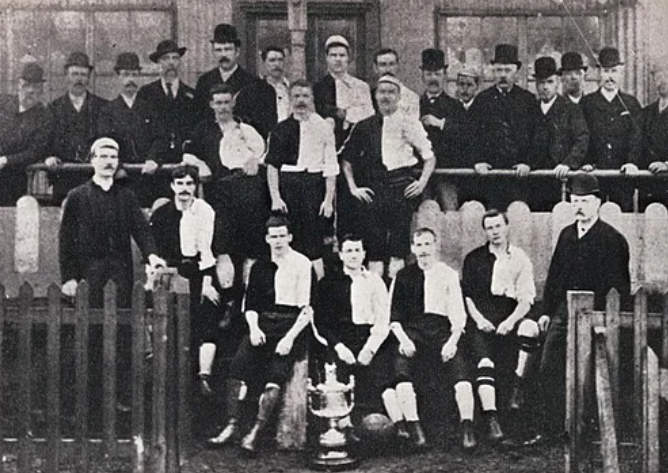
Newton Heath L&YR Football Club 1888 via American Red Devils
Manchester United’s history begins in 1878, not with its iconic name, but as Newton Heath LYR Football Club. Formed by workers from the Lancashire and Yorkshire Railway (LYR)’s carriage and wagon department, the club started as a modest team competing against other railway companies and industrial organizations.
Their matches were held at North Road, a simple ground that reflected the club’s working-class origins. These games were far from genius, but they planted the seeds of a beautiful history of a team that is gigantic nowadays.
During its formative years, Newton Heath faced significant challenges. With limited resources, the club relied heavily on support from the local community. Despite these obstacles, their passion and determination allowed them to compete in the regional football leagues.
By the early 1890s, Newton Heath joined the Football League, marking the first steps of the club into professional football. However, the transition was far from smooth. Financial instability, coupled with poor performances, left the club without many outings.
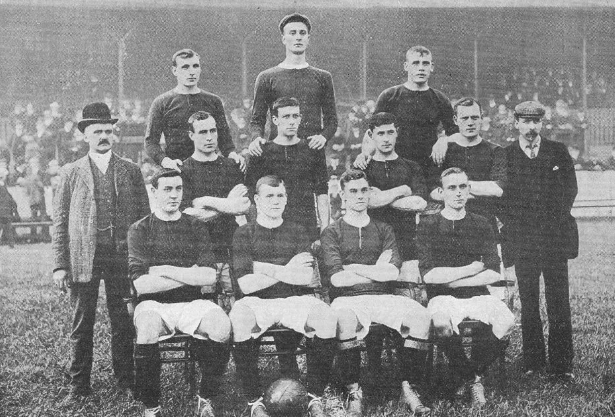
1905/06 Manchester United squad via American Red Devils
In 1902, Newton Heath was almost bankrupt, with debts increasing and the future of the club without much perspective. Since the payment of debts would be inevitable, the intervention of local businessmen proved to be a turning point. John Henry Davies, a brewery owner, recognized the potential of the club and tried to save it from collapse.
Davies paid the debts and later invested in improving the club’s infrastructure. Under his guidance, the club rebranded as Manchester United Football Club, giving it a new beginning and a longing for ambitions that extended beyond the local rail yards.
The name change in 1902 marked more than just a financial rescue—it symbolized a transformation in identity. Manchester United wanted to represent the city, distancing itself from its industrial roots and dreaming of being a giant in league football.
Pre-War Struggles and Triumphs (1902-1945)
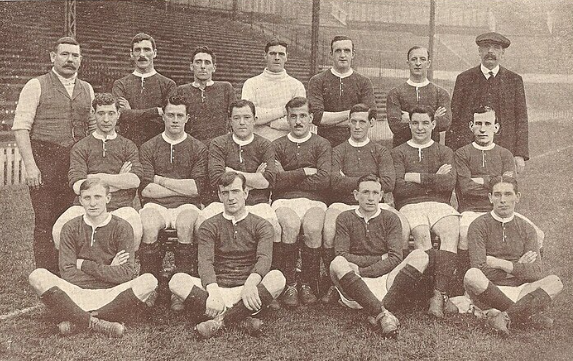
1913/14 Manchester United squad via Wikipedia
The rebirth of Manchester United in 1902 created a new era, but the road to success remained challenging. With John Henry Davies in charge of the club as president, Manchester United began to save money for future growth.
In 1908, under the management of Ernest Mangnall, Manchester United won their first Football League title, showcasing the potential of the club to compete at the highest level with other clubs in England. This victory was followed by the first FA Cup victory of the club in 1909, against Crystal Palace.
In 1910, the club moved to Old Trafford, their new stadium. This change represented an upgrade. Old Trafford’s capacity and its modern design were far ahead of its time, reflecting the ambition to make Manchester United the dominant football club in the country.
The inaugural match at Old Trafford, however, ended in a 4-3 defeat to Liverpool, showing that while the infrastructure was in place, the squad still needed development.
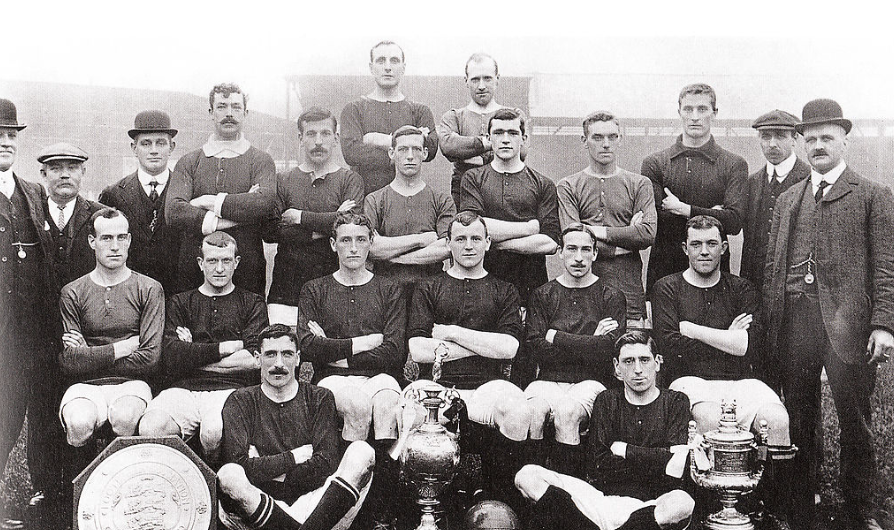
1908/09 Manchester United squad with first ever Charity Shield and FA Cup trophy via Wikipedia
The First World War (1914-1918) made football stop, with many players summoned to fight. Manchester United, like many other clubs, suffered from the tragic losses of talents during the conflict.
The interwar years proved difficult, with performances below standard and relegation to the Second Division in 1922. Despite these little moments of resurgence, including promotion back to the First Division in 1925, the club found it difficult to maintain the quality and consistency. Financial problems happened once again in the 1930s, almost generating another collapse.
During this period, James Gibson, a local businessman, stepped in to rescue the club in 1931. His investment revived Manchester United, making the club walk on the rails again. At the outbreak of the Second World War, the club was more in order, but it hadn’t yet reached its maximum potential.
The war, however, once again disrupted league football, forcing United and other clubs in England to participate in regional competitions. The end of the war in 1945 was important, because it was the crucial point for the success of the English club.
Busby Babes and Munich Air Disaster (1945-1958)
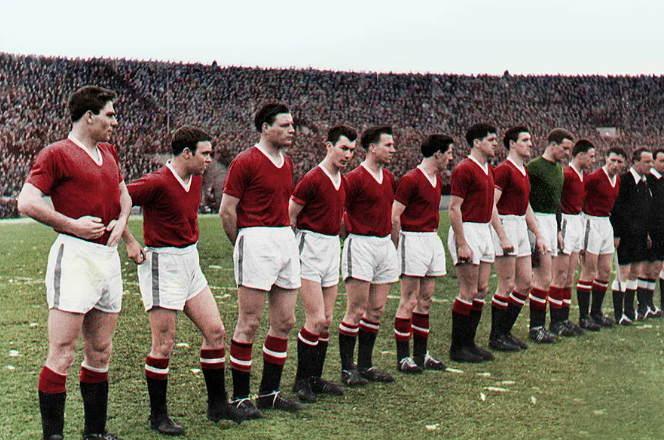
1945/46 Manchester United in the post war season via American Red Devils
In the post-war years, Sir Matt Busby took charge as manager in 1945, bringing a deep understanding of the club and a vision to guide it to future glory. His approach was defined by a commitment to youth development, an emphasis on captivating football, and the creation of a squad built for long-term success.
At that time, most clubs bet on experienced players, but Busby’s faith in young talent worked, and his philosophy reaped great achievements.
In the early 1950s, Busby bet in a squad with youthful promise, later known as the Busby Babes. These players, many of them formed in Manchester United’s youth academy, delivered immediate results.
United conquered First Division titles in 1952, 1956 and 1957, dominating English football with a unique style of play with their young players. The squad, with stars like Duncan Edwards, Bobby Charlton and Roger Byrne, fought a lot for continental glory, representing the vanguard of English football in European competitions.
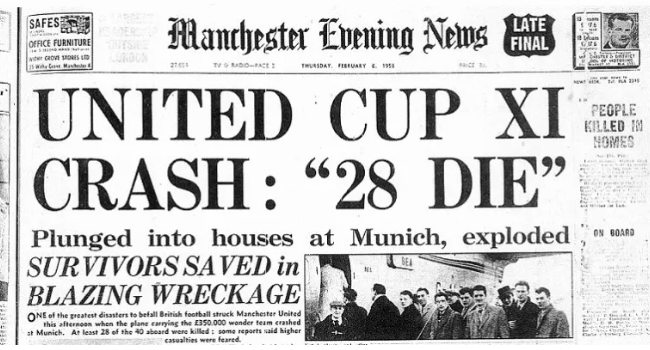
Munich Air Disaster in 1958 via American Red Devils
However, on February 6, 1958, a tragedy occurred in what became one of the darkest chapters in Manchester United’s history. Returning from a European Cup match against Red Star Belgrade, the team’s airplane crashed at Munich-Riem Airport after refueling.
The Munich Air Disaster tragically claimed the lives of eight players and three staff members, shattering one of the greatest teams ever assembled in football history. Among the victims was Duncan Edwards, one of the most talented players of his generation, who succumbed to severe injuries, including leg fractures, broken ribs, and critically damaged kidneys.
The disaster shocked the footballing world. The club, fighting against the loss of players and leadership, faced an uncertain future. Sir Matt Busby, who survived the crash, spent months recovering and couldn’t participate in the team’s game.
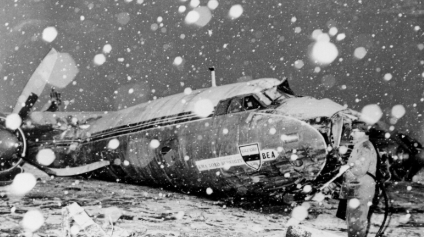
The airplane of Munich Air Disaster via Sky News
Under the guidance of assistant manager Jimmy Murphy, the club reached the FA Cup final, which they lost to Bolton Wanderers, just months after the tragedy, showing the commitment of United fans and the football community.
The Munich Air Disaster left a hard mark to forget for the people and Manchester United. The union of supporters, fans, and the city of Manchester, showed that the club is more than a football team – it symbolized hope, strength, and the desire to succeed again.
Rebuilding and European Success (1958-1969)
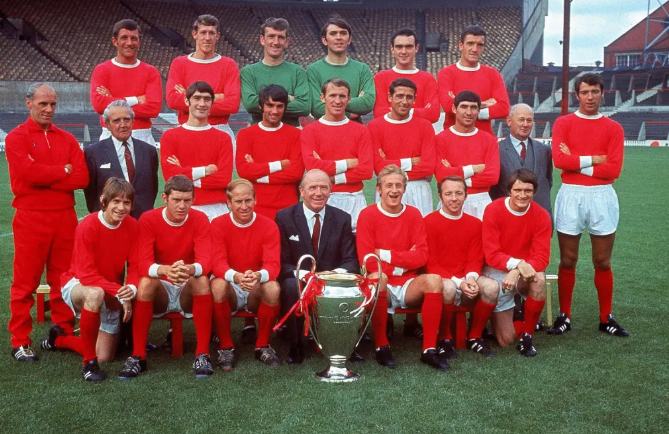
Busby recovered the team through the 1960s via American Red Devils
After the Munich Air Disaster left Manchester United in ruins, Busby and the club’s determination to recover is an example to be followed. Under Jimmy Murphy, who temporarily took over while Sir Matt Busby recuperated, United reached the 1958 FA Cup final.
With Sir Matt Busby’s return to management, Manchester United embarked on a long rebuilding process, centered on discovering new talents to replace the stars lost in the Munich Air Disaster.
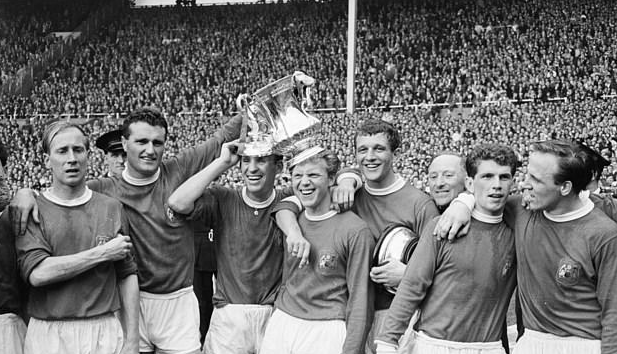
1963 FA Cup final via Daily Mail
Throughout the early 1960s, Busby continued to develop his squad, integrating experienced players with emerging youth players. The acquisitions of Denis Law from Torino, Italy, and the development of young stars George Best and Bobby Charlton revitalized the team.
In 1965, Manchester United conquered the First Division title, showing their return to the success of English football. This period established Manchester United as a giant in domestic competitions, winning another league title in 1967 and almost always challenging for top positions in the tournaments.
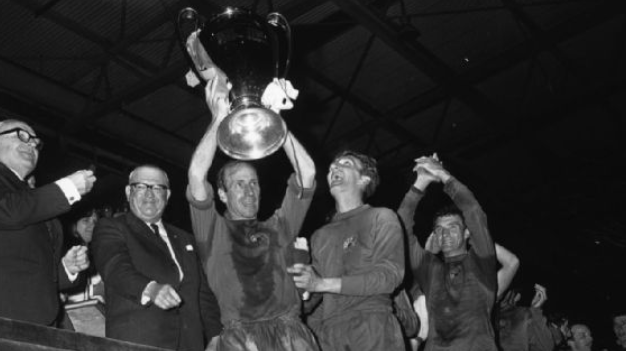
Manchester United team in 1968 lifting the 1967/68 European Cup trophy via ESPN
The biggest triumph of this era was in 1968, when the club became the first English club to win the European Cup. In a dramatic game, the club won the final in Wembley, defeating Benfica 4-1 after extra time, with goals scored from Bobby Charlton (two times), George Best and Brian Kidd.
This victory had an important meaning: a tribute to Busby Babes, players who had passed away in the previous decade. In addition to having a very special feeling about this achievement, it was important for the club to succeed again in England and Europe.
Ferguson Era
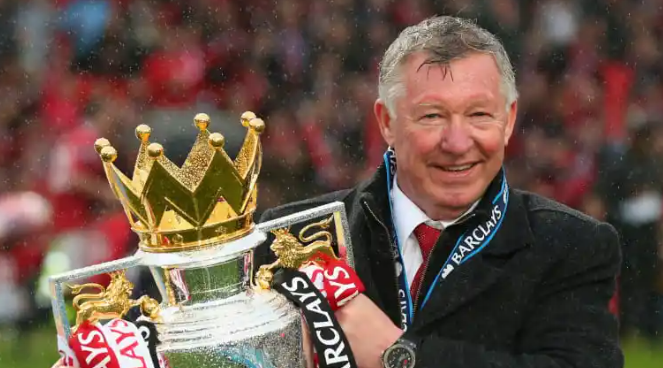
Sir Alex Ferguson via American Red Devils
Manchester United appointed Sir Alex Ferguson in 1986 after dismissing Ron Atkinson, marking the beginning of a new era for the club. Ferguson took over a struggling team, but through his leadership and tactical brilliance, he gradually restored Manchester United to its former glory.
In the early 1990s, Sir Alex Ferguson made some changes in the squad, combined with the promotion of youth talents from the United’s academy, making the team start to take shape. The coach was developing players like Ryan Giggs, David Beckham, Paul Scholes, Garry Neville and Nicky Butt, forming the base of a squad that would dominate English football in the next years.
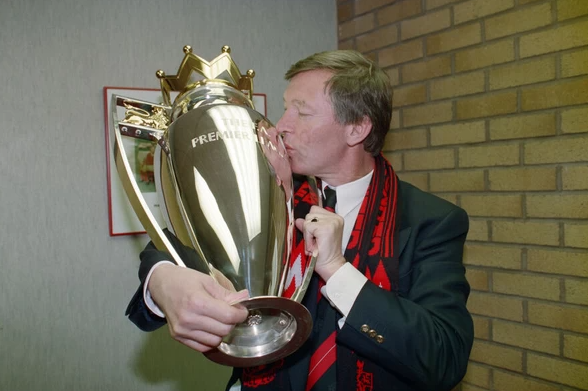
First Premier League title of Alex Ferguson in 1992/93 season via Media Store House
The first season of success under Ferguson came in 1992/93 season when they conquered their first Premier League title, ending a 26-years wait for league glory. This victory showed a golden era in Manchester United and a domain over their domestic rivals, winning over 10 league titles throughout the 1990s and early 2000s.
The hiring of stars like Eric Cantona, Cristiano Ronaldo, Roy Keane and Peter Schmeichel, each one in your era, boosted the squad of United, ensuring their legacy in the Premier League. In 1999, Ferguson and the players made history, they completed a treble, winning the Premier League, FA Cup and UEFA Champions League in the same season – an achievement that only their rival, Manchester City, conquered in the 2022/23 season.
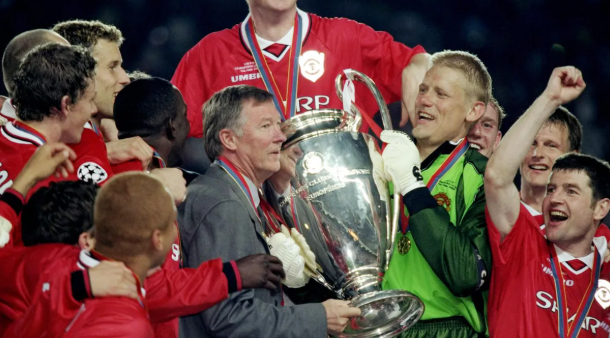
Manchester United winning the treble after the 1998/99 UCL final via Eurosport
The 1999 UEFA Champions League final against Bayern Munich showed the commitment and the spirit of the club and players to duel until the end of the game to win trophies. United was losing 1-0 the final, but in the injury time, goals from Teddy Sheringham and Ole Gunnar Solksjaer in the final moments guaranteed a 2-1 victory for the Red Devils.
Ferguson has always been a coach who knew how to put together his teams very well. Whenever he lost a player, he hired players who would make a difference in his game tactics. Therefore, United continued to be successful during his guidance and was a dominant team in England and Europe for a long time.
By the time Ferguson retired in 2013, he led the club to 13 Premier League titles, five FA Cups and two Champions League triumphs, and more than 10 domestic championship titles.
Post-Ferguson Challenges (2013-Present)
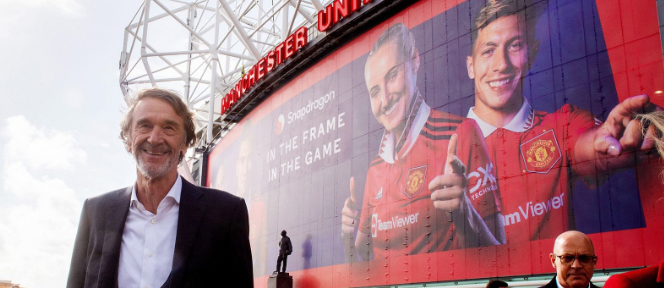
New owner of the club, Jim Ratcliffe via Sky Sports
When Sir Alex Ferguson retired in 2013, it was the end of an era, and Manchester United faced a period of uncertainty. Ferguson always kept the club and the players at the highest level in English football for over two decades.
But United hired David Moyes, and he can’t replicate the success of Ferguson, of course. Despite the high investment in the squad, the performances were poor, not being able to get the best of their players, so Moyes was fired after only ten months.
After the coach was sent away, the club went through a turbulent period, with a series of managerial changes thinking that they could reorganize the club.

Manchester United under Louis van Gaal via Goal
Under Louis van Gaal, United had a mix of results, guaranteed a FA Cup in 2016 but failing to conquer the league title. The passage of Van Gaal was marked by his rigidity with the players and inconsistent performances, leaving the club far from what he wanted.
In 2016, José Mourinho took over the position of coach, bringing hope to Old Trafford and the fans. The Portuguese manager led the team to two major trophies in his first season, the Europa League and League Cup (Carabao Cup nowadays). However, Mourinho’s relationship with the players and the team was dismantled over time, resulting in your departure in 2018.
The post-Ferguson era was complicated and full of inconsistencies on the part of the club and its management, making United continue to fight to return to its dominant team position in England and Europe.
Ole Gunnar Solskjaer, a former player of United and a hero of the 1999 treble, was hired as the manager in 2018. He brought optimism and led the team until the Europa League semi-finals in 2021.
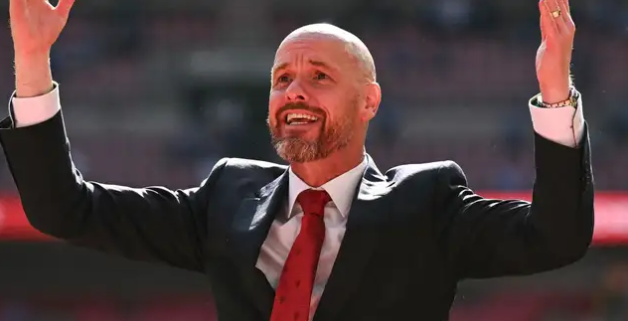
Manchester United under Erik ten Hag via Goal
Under Ralf Rangnick and after Erik ten Hag in 2022, Manchester United still faced challenges to rebuild their past success and return to its glory. Now, in the hands of Rúben Amorim, the Portuguese coach will try to get the best of his players and lead the club once again until success.
Iconic Matches in Manchester United’s History
Manchester United’s history is filled with unforgettable matches that have left an indelible mark on football. From thrilling victories and dramatic comebacks to iconic moments on the pitch, the legacy of the Red Devils continues to captivate fans around the globe.
Join me as we revisit legendary league battles and historic European triumphs—let’s see if any of these games spark your memories!
1999 UEFA Champions League Final
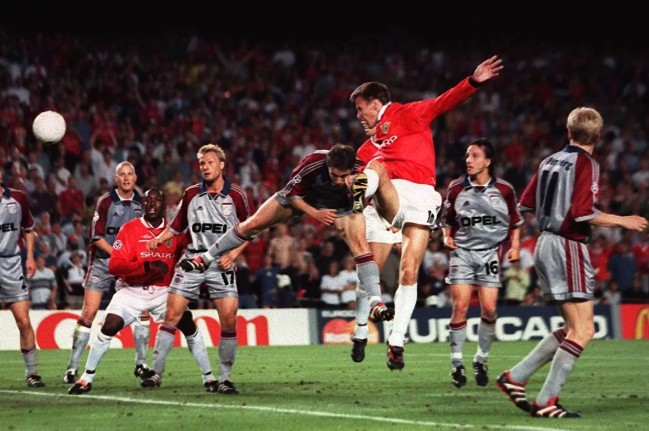
Goal in the 1998/99 UCL final via Mirror
One of the most iconic games in the history of Manchester United occurred on May 26, 1999, during the UEFA Champions League final against Bayern Munich at the Camp Nou in Barcelona.
United was losing the game 1-0 until injury time, when they made an unforgettable comeback, scoring two goals in a row. Teddy Sheringham and Ole Gunnar Solskjaer were the heroes, guaranteeing a 2-1 victory for Sir Alex Ferguson and his players.
This match secured the first European Cup/Champions League in 31 years and completed their historic treble of the Premier League, FA Cup and Champions League.
2008 UEFA Champions League Final
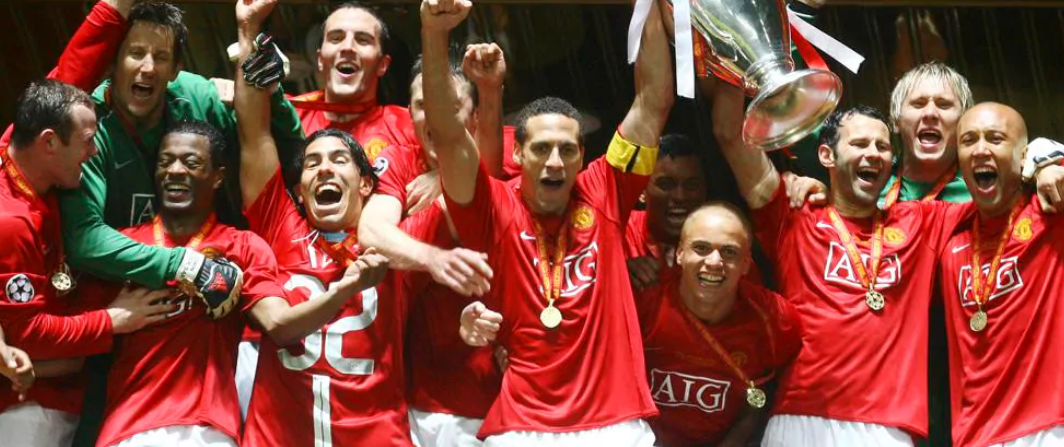
2007/08 UCL final with Manchester United lifting the trophy via UEFA
After almost 10 years without European glory, Manchester United returned to the height of European football in 2008. In the final against Chelsea, the first all-English final in history, United fought through a tense match.
The game ended 1-1 after extra time, with goals from Cristiano Ronaldo and Frank Lampard. The final was decided in a penalty shootout, with United winning 6-5.
Edwin van der Sar, legendary goalkeeper of Manchester United, saved the penalty of Nicolas Anelka, conquering the third European triumph of the club. This victory crowned Sir Alex Ferguson and his squad as one of the greatest clubs in European football.
1968 European Cup Final
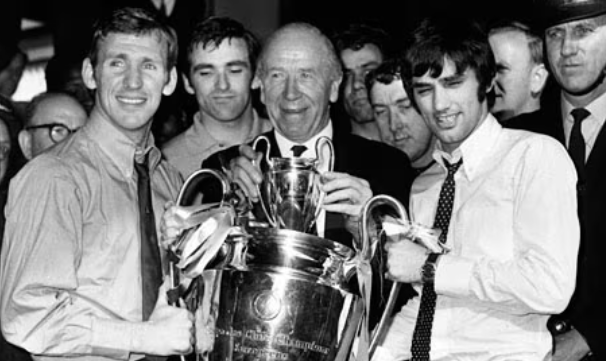
Manchester United with the European Cup trophy in 1968 via The G uardian
On May 29, 1968, Manchester United won their first European Cup in a final against Benfica in Wembley. The match ended 4-1 after extra time, with goals from Bobby Charlton with two goals, George Best and Brian Kidd.
This victory was special because it marked the resurgence of Sir Matt Busby and the team after the Munich Air Disaster in 1958.
It was the first time that an English club won Europe’s most prestigious competition. This victory remains important for Manchester United and their history because it will be remembered forever by the legacy of Sir Matt Busby and the Busby Babes.
1963 FA Cup Final
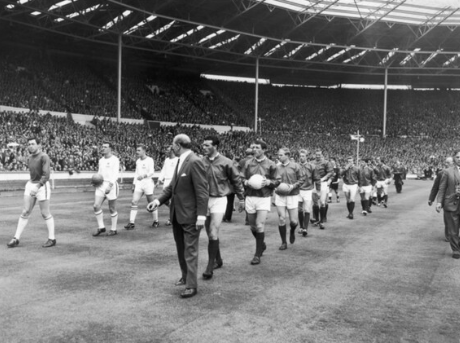
Manchester United and Leicester City walking to the pitch in Wembley via Magnolia Box
In 1963, Manchester United triumphed over Leicester City 3-1 in the FA Cup final at Wembley, an important victory for the club in the club’s post Munich recovery.
The match was a symbol of hope and regeneration after the tragedy that affected the club just five years earlier. The victory of Manchester United players was driven by star players like Dennis Viollet and future legends of the club, such Bobby Charlton.
The win was important for the trophy cabinet of the club, but especially marked a new beginning in their journey and a promising future under Sir Matt Busby.
1995/96 Premier League Title
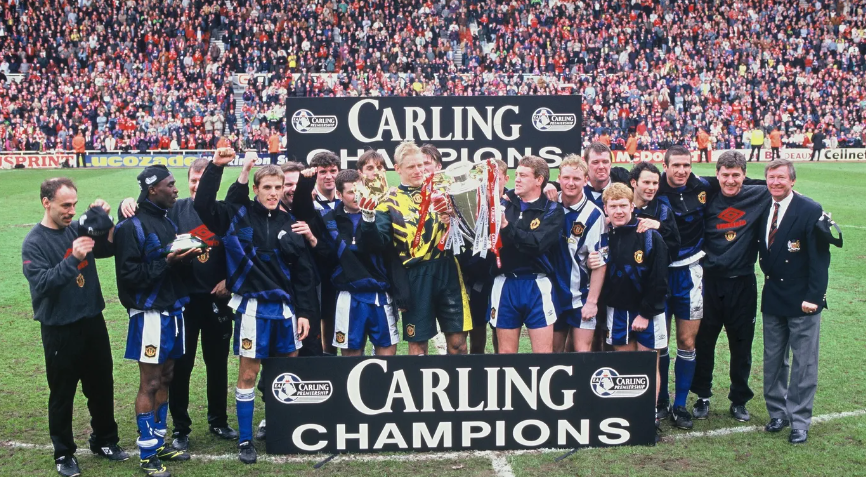
1995/96 Premier League trophy via Premier League
The 1995/96 Premier League season’s title was one of the most exciting in the competition’s history. On the final day of the season, Manchester United faced Newcastle United.
After a long and hard battle at the top of the table, United conquered the title with a 3-0 victory at St. James Park, thanks to goals from Eric Cantona, David Beckham, and Brian McClair.
This victory was significant as it demonstrated Ferguson’s team’s ability to deliver high-quality performances when it mattered most—a hallmark of their success, especially in the finals they competed in.
Iconic Players of Manchester United
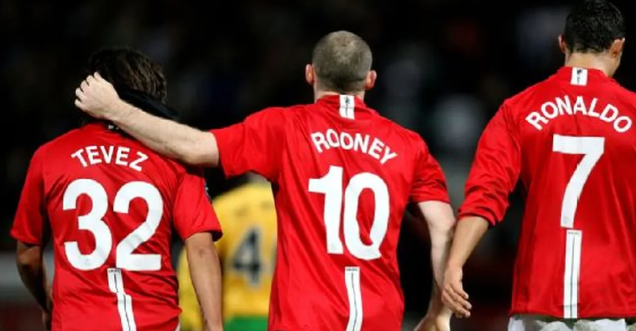
Carlos Tevez, Wayne Rooney and Cristiano Ronaldo via GE
Throughout its beautiful history, Manchester United has had numerous iconic players who have contributed to the club and its success.
Now, I’ll show you some important players from the Busby Babes and Ferguson era. After reading this text, tell me which player is your favorite!
Bobby Charlton
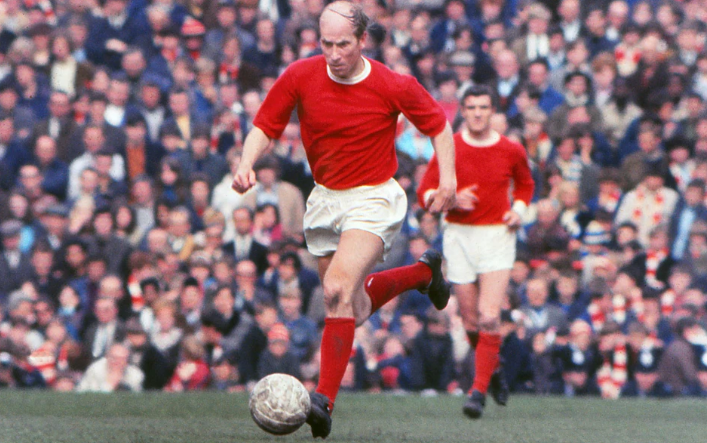
Bobby Charlton via Telegraph
A symbol of Manchester United, Bobby Charlton was a member of the Busby Babes and survived the Munich Air Disaster to become the club’s top scorer for many years. Bobby was overcome by Wayne Rooney in recent years. The England player scored 253 goals and broke the record.
Bobby played an important role in their European Cup triumph in 1968. The player always dedicated himself to the club and had success with England in winning the 1966 FIFA World Cup.
Bobby passed away in 2023 at the age of 86, due to complications of dementia.
George Best
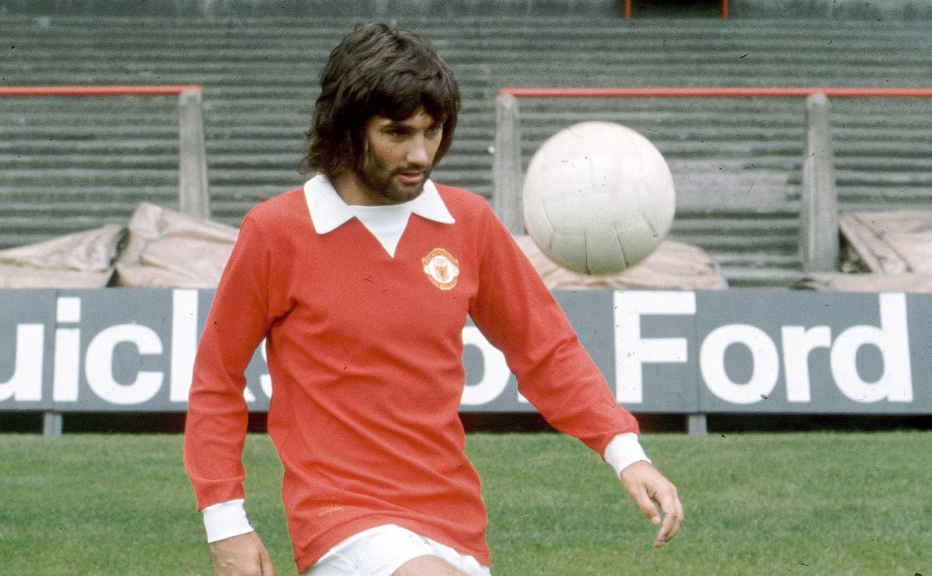
George Best via Independent
George Best was a magician with the ball. His dribbling skills, speed, and creativity made him a fan favorite at Old Trafford. Best was an important part of the United’s success in the 1960s, and his charm, both on and off the field, turned him into an international icon.
His winning goal in the 1968 European Cup final was one of the best moments of his career. All his influence on the field for United was important for the club’s achievements, becoming a legend.
Best passed away in 2005 at the young age of 59, suffering from a kidney infection caused by the effects of immunosuppressive drugs used for his treatment.
Eric Cantona
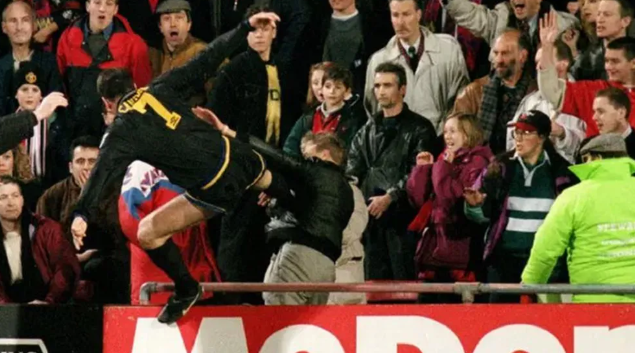
Eric Cantona via O Globo
Eric Cantona is known for his personality and flair on the pitch. Cantona was an intriguing figure at Manchester United during the 1990s. Arriving in 1992 from Leeds United, Cantona brought all his ability to complete the United’s attack. Under Sir Alex Ferguson, Cantona helped lead the team to four Premier League titles in five seasons.
The former player is 58 years old and after his retirement, he migrated to a musical career, in addition to having played roles in streaming series, such Netflix.
Cristiano Ronaldo
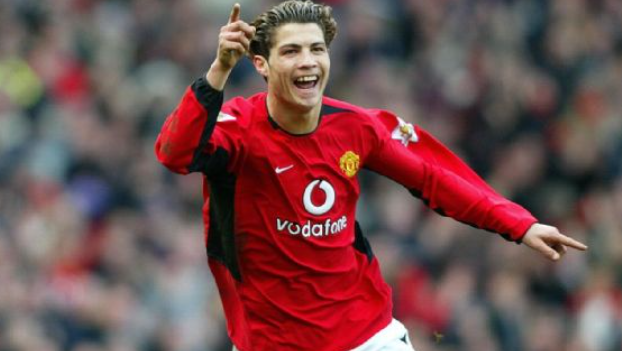
Cristiano Ronaldo via ESPN
Cristiano Ronaldo joined Manchester United in 2003 from Sporting CP, Portugal, as a talented and young winger. Under the guidance of Sir Alex Ferguson, Manchester United manager, he developed into one of the greatest players in the world.
His speed, dribbling skills and ability to score goals, helped United to win three consecutive Premier League titles from 2007 to 2009, as well as the 2008 UEFA Champions League . Ronaldo became the best player of the world in 2008, winning the Ballon d’Or.
After leaving the club for Real Madrid in 2009, Ronaldo returned to Manchester United in 2021. Although his second stint did not replicate the success of his first, there is no doubt that Ronaldo secured his place in the club’s storied history.
Nowadays, Ronaldo plays for Al Nassr from Saudi Arabia and also is the captain of the team.
Ryan Giggs
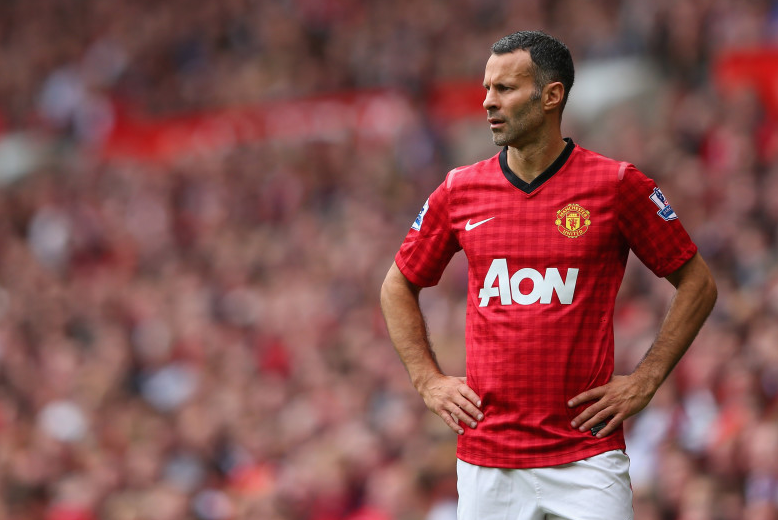
Ryan Giggs via Bleacher Report
Ryan Giggs stands as one of the most beloved players in Manchester United’s history, dedicating his entire career to the club and setting a record with 802 appearances.
During the 1990s and early 2000s, Giggs was instrumental in the team’s success, contributing to 13 Premier League titles and two Champions League trophies.
He is also part of an elite group—one of just 44 players in football history to have made over 1,000 career appearances.
Old Trafford: The Theatre of Dreams
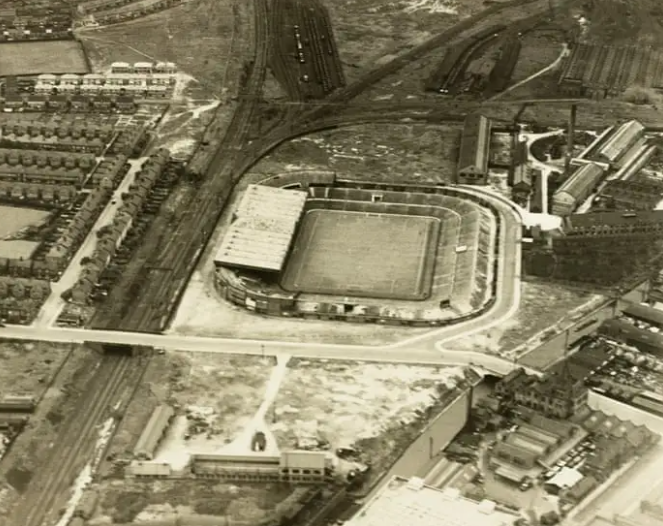
Old Trafford in 1910 via American Red Devils
Old Trafford is known as “The Theatre of Dreams”, the stadium is a symbol of the legacy of Manchester United. In 1909, John Henry Davies donated funds to build the venue. Since its opening in 1910, Old Trafford is the home of the club and hosting memorable moments that made part of United’s history.
The stadium is located in Old Trafford, Stretford, Manchester M16 0RA, in the city of Manchester, United Kingdom. Its capacity is 74,310 and its last reform happened in 2006.
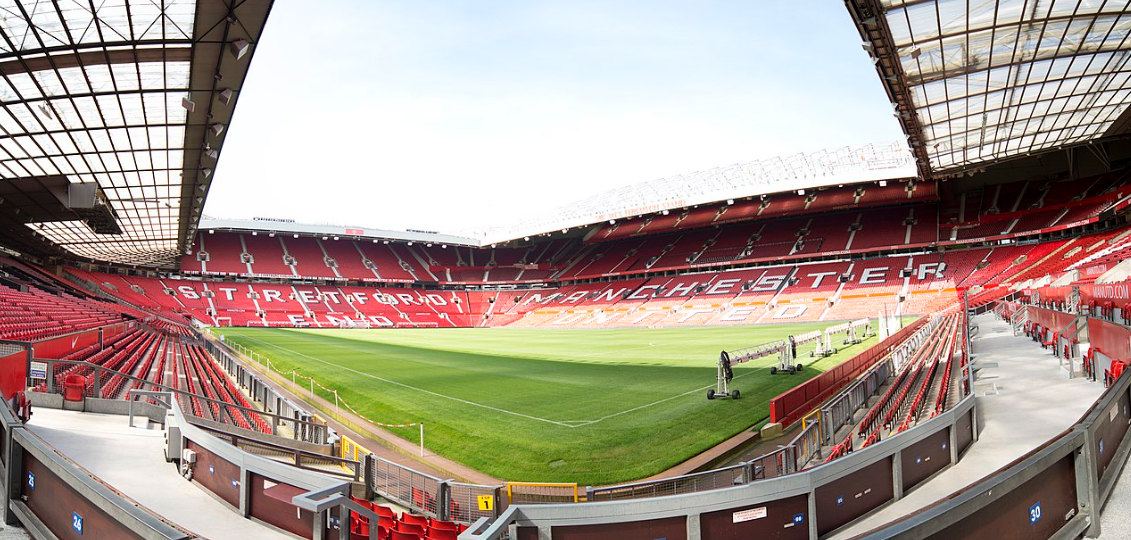
Inside the Old Trafford Stadium via Wikipedia
Over the decades, Old Trafford has undergone several expansions and renovations to better accommodate the club’s passionate supporters. In its most recent expansion, the stadium’s capacity increased to over 74,000, making it second only to Wembley Stadium, which holds 90,000 fans.
The North Stand, renamed “The Sir Alex Ferguson Stand” in honor of the club’s most successful manager, offers fans an exceptional view of the pitch, as does the South Stand.
However, the most iconic section of Old Trafford is the “Stretford End,” a stand that has become a powerful symbol of Manchester United’s legacy and dominance.
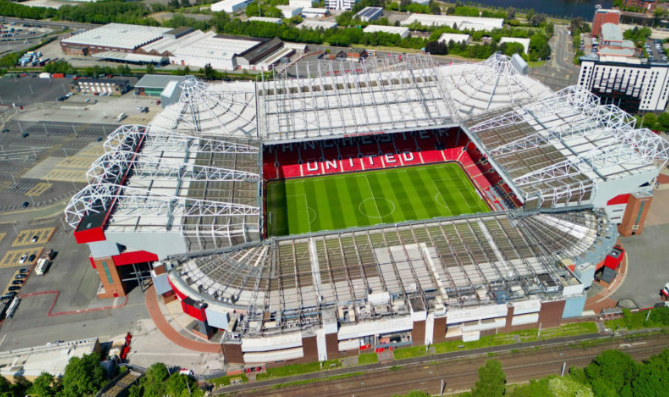
View of Old Trafford via Poder360
In September, 2024, the club announced that they have plans to build a new stadium for Manchester United. The new stadium will have a capacity of 100,000 and will cost approximately two billion pounds.
The stadium will be the largest in England and Europe. With the construction of this venue, it promises to generate 90,000 jobs. The project is a collab with Foster + Partners, known for developing the new Wembley Stadium project.
Trophies and Achievements
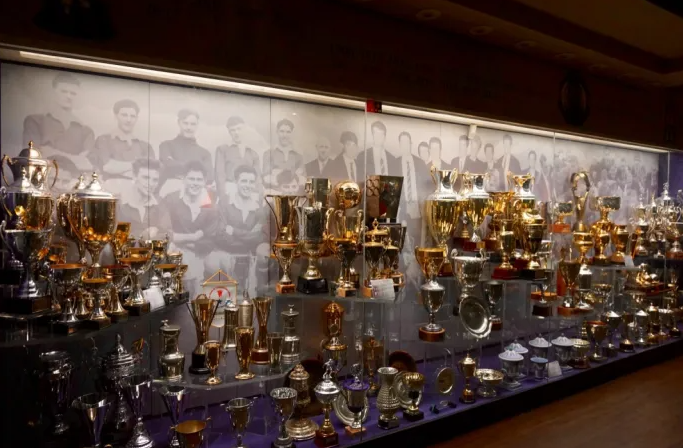
Trophy room of Manchester United via Viajonários
The club has a large trophy room. After seeing Manchester United’s achievements, tell me if you remember any of their games in which they won one of these titles and lifted the trophy!
- 20 English League titles (Premier League and First Division)
- 13 FA Cups
- 3 European Cup or UEFA Champions League titles
- 1 UEFA Europa League
- 21 FA Charity Shield or FA Community Shield
- 6 EFL Cup (known as Carabao Cup now)
- 1 Intercontinental Cup and 1 FIFA Club World Cup
The history of Manchester United is a beautiful story that is far from finished. The Red Devils have secured their place among the greatest teams in Europe and the world. While the road has been filled with challenges and obstacles, the club’s journey has shown us that football is about more than just trophies—it’s about the passion, dreams, and the resilience that define the journey itself.
Recent years have brought significant challenges, but the identity of Manchester United remains steadfast. Rooted in a rich tradition and the unwavering loyalty of its players and supporters, the club continues to embody the spirit of greatness and the pursuit of future triumphs.
Became a Champion in the Football League with FootballTeam

If you’ve made it this far, there’s a good chance you’re a passionate football fan, right?
If your dream is to become the ultimate player and showcase your love for the game, I’ve got great news for you: FootballTeam is the perfect game to bring your passion to life!
Dive into this immersive football experience where you can demonstrate your knowledge, build your dream team, and even design your ideal stadium. Compete with friends and players worldwide as you climb the ranks and achieve greatness!
Best of all, FootballTeam is available on both desktop and mobile devices, ensuring you can play anytime, anywhere. Don’t wait — Sign up now and play for free!